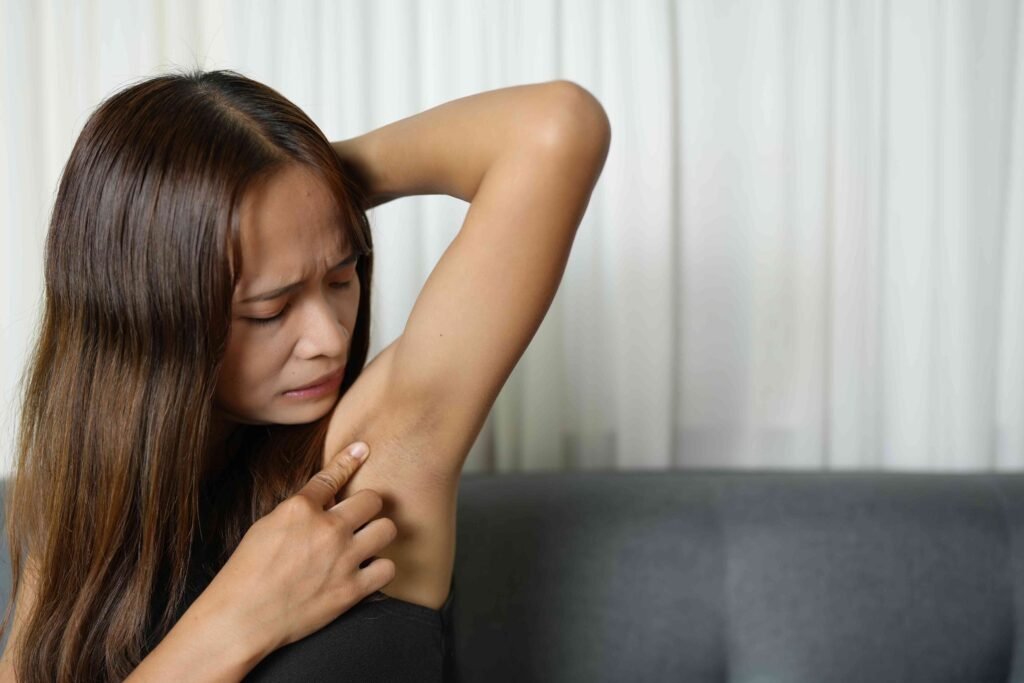Understanding Armpit Rashes: Causes, Symptoms, and Treatments
Armpit rashes can be bothersome and sometimes embarrassing, stemming from various causes such as infections, allergies, and inflammation. This article explores the potential causes, symptoms, and treatments for underarm rashes, ensuring you stay well-informed and prepared.
Common Causes of Armpit Rashes
Understanding the root of an armpit rash is crucial for effective treatment. Here are some common causes:
1. Contact Dermatitis (Allergic and Irritant)
- Allergic Contact Dermatitis: This occurs when your skin encounters an allergen. Potential triggers can include fragrances, preservatives in skincare products, and even plants like poison ivy.
-
Irritant Contact Dermatitis: More common than its allergic counterpart, this rash develops from repeated exposure to irritants, such as deodorants or soaps.
Treatment Options:
- Avoid irritants and allergens.
- Wash the affected area thoroughly.
- Use topical corticosteroids for relief.
2. Hidradenitis Suppurativa (HS)
-
This chronic skin condition occurs in areas with apocrine glands. HS leads to painful, pus-filled bumps that can burst and form tunnels in the skin.
Managing HS:
- Mild Cases: Topical antibiotics and cleansers.
- Moderate Cases: Oral medications.
- Severe Cases: Injectable biologics such as Adalimumab (Humira).
3. Folliculitis
-
Characterized by red, pimple-like bumps, folliculitis arises from infected hair follicles. Common triggers include shaving and tight clothing.
Treatment Options:
- Avoid shaving temporarily.
- Use over-the-counter creams, like hydrocortisone, for relief. Severe cases may require antibiotics.
4. Acanthosis Nigricans (AN)
-
Not a rash per se, AN manifests as dark, velvety patches in skin folds. Linked to obesity and hormonal changes, it can signal underlying health issues.
Treatment:
- Targeting underlying causes.
- Topical retinoids and laser treatments for skin appearance.
5. Intertrigo
-
This rash results from skin rubbing against skin, typically in warm, moist areas. It may ooze or crack, making it susceptible to infection.
Treatment Strategies:
- Keep the area cool and dry.
- Employ antifungal or antibiotic creams as necessary.
6. Inverse Psoriasis
-
Affecting skin folds, inverse psoriasis presents as smooth, shiny patches. Unlike typical psoriasis, it doesn’t produce the expected scales.
Treatment Options:
- Topical steroids initially, with more severe cases requiring biologic therapy.
7. Ringworm
-
This fungal infection leads to scaly, ring-shaped patches. It’s easily spread through contact with infected individuals or surfaces.
Management Methods:
- Use topical antifungal treatments available over the counter.
8. Cutaneous Candidiasis (Yeast Infection)
-
Common in warm areas like the armpits, this fungal infection arises from an overgrowth of Candida.
Treatment:
- Drying powders and antifungal creams can help alleviate symptoms.
9. Heat Rash (Miliaria)
-
Often referred to as prickly heat, this occurs when sweat glands are blocked. Small, itchy bumps may develop in response to heat.
Relief:
- Ensure the skin remains cool and dry; topical lotions may be recommended.
10. Cutaneous Lymphoma
-
A rare skin cancer affecting lymphocytes, it presents as patches, nodules, or plaques. If swollen lymph nodes occur, they may signal a more serious condition.
Recommendation:
- Consult healthcare providers for tailored treatments based on the specific type.
Seek Medical Advice
If you experience persistent symptoms like an itchy, irritated armpit, it’s vital to consult a healthcare professional, specifically a dermatologist. Proper diagnosis ensures the alignment of treatment options with the underlying cause.
Quick Review: Identifying Armpit Rashes
These rashes can stem from various roots, including:
- Fungal infections (ringworm, yeast).
- Inflammatory conditions (hidradenitis suppurativa, inverse psoriasis).
- Allergic reactions (contact dermatitis).
Key Takeaways
- Always seek expert medical advice for persistent rashes.
- Treatments vary based on the underlying cause—ranging from creams and ointments to advanced therapies.
- Keeping the area dry and clean is essential to prevent further irritation and infection.
For more in-depth information on skin health, explore resources from the American Academy of Dermatology and Mayo Clinic.
By understanding the various causes and treatments for armpit rashes, you can take proactive steps to address skin irritations effectively!


